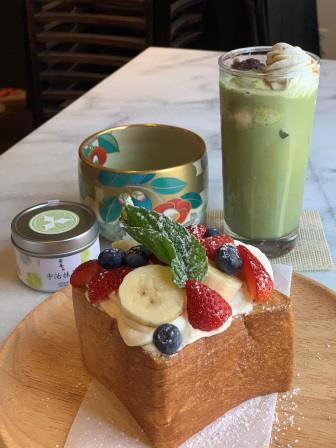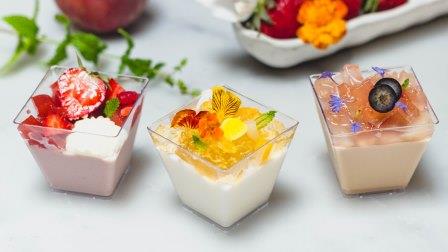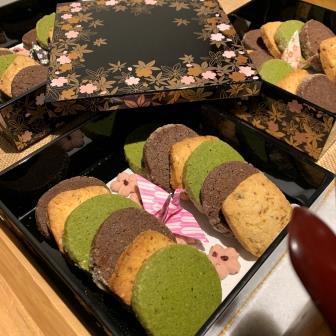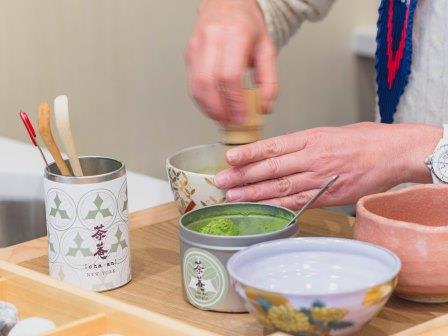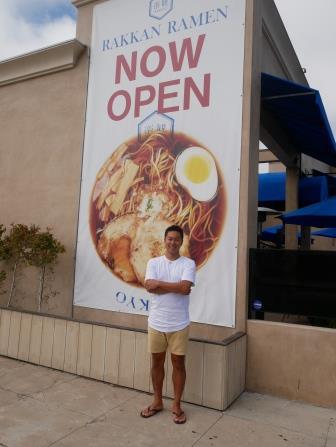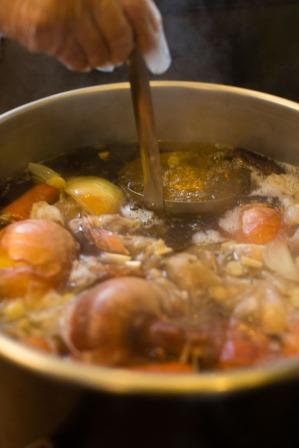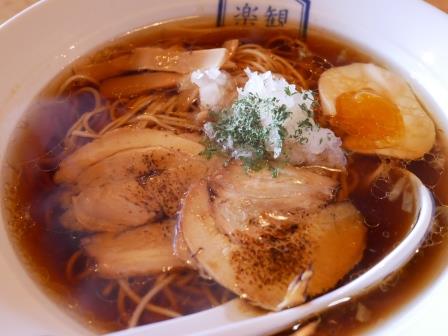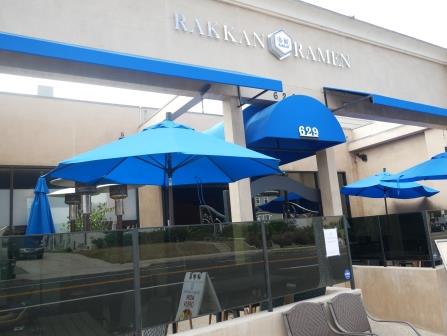To Prepare for the Holiday Season
By Yuji Matsumoto
When we get into December, restaurants start becoming busy with year-end parties and Christmas parties, and we should start preparation from the beginning of November. During this time, wines and champagnes are consumed a lot and even served by restaurants, and it is disappointing that sales of Japanese sake is slightly held back by them. However, if you think of what goes good with food, I feel that Japanese sake is the winner. Also it can be consumed at different temperatures and I am happy that hot sake can warm up your body during the cold seasons.
With some thought out presentations, you can drink Japanese sake in style.
Let's start with the glass. By using the white wine glass instead of the usual Japanese sake glass, you can increase the luxury at your table. If you like sparkling alcohol like champagne, it would be interesting to serve sake in a flute glass. Varieties of sparkling Japanese sake has increased recently and we're thankful that they are being sold at reasonable prices. Also, we would like you to try flavor sake which is popular during this season.
If you like to drink hot sake, we suggest you buy the sake warming set on the market that uses candles to warm sake. This would be a very good match with Western style foods.
ホリデーシーズンに備える
12月に入るとすぐに忘年会、クリスマスパーティーなどでレストランは忙しい時期となる。11月初旬からすでに準備をしていきたい。この時期ワインやシャンペンは多くレストランでも出るようになるが、日本酒となるとややこれらにおされ気味になるのが残念である。
しかし、食との相性を考えると日本酒が勝ると思う。しかも温度帯も広く、寒い時期には燗酒を飲むことにより身体とも暖めてくれるのがうれしい。
ちょっとした演出により、おしゃれに日本酒を飲むことができる。
まずは、グラス。いつもの小さい日本酒グラスではなく白ワインのグラスを使用することにより、食卓に豪華さが増す。
シャンペンなどの発砲酒が好みならフルートグラスで提供してみると面白い。最近は日本酒の発泡酒の種類も多くなり、手軽な価格になっているのでありがたい。また、同じくフレイバー酒もこの時期に好まれるのでぜひトライしていただきたい。
燗が好きな方は、市販で買えるロウソクで暖める燗セットをお勧めする。これなら、洋食の食卓にもとてもマッチするのである。
為節日季節作準備
因甫踏進十二月,便有尾牙餐會、聖誕派對等令餐廳非常忙碌的節目;故皆希望能夠於十一月上旬起已開始作準備。在此期間,許多餐廳會提供葡萄酒和香檳等;但遺憾當提及清酒,則有種略微被壓下的感覺。
但是,當考慮到與料理的襯托程度時,個人認為清酒更勝一籌。此外,清酒的溫度範圍廣;在寒冷的天氣裡喝燗酒(註:熱清酒),令身體更感溫暖,倍添快意。
只需少量心思,就可以時尚地品嘗清酒。
首先,玻璃杯。使用白葡萄酒用的玻璃酒杯代替平時清酒用的小酒杯可以增加餐桌的奢華感。
如果您喜歡香檳等發泡酒,可嘗試將其與香檳杯一起飲用。而值得慶幸的是近來,清酒的發泡酒種類也有所增加,以及已經成為能夠易於負擔的價格。另外,這時期的加香酒亦大受歡迎,請務必嘗試。
對於喜歡燗酒的人,建議使用可以在市場上購買,以蠟燭作加熱方法的燗酒套件。至此,就能變得與西式餐桌非常匹配。
홀리데이 시즌을 준비하며
12월에 들어서면 송년회며 크리스마스 파티 시즌 등이 금새 돌아오기 때문에, 레스토랑은 바빠지기 전인 11월 초순부터 이미 준비를 해나가야 합니다. 이 시기에 많은 레스토랑에서 와인이나 샴페인을 출시하는데, 니혼슈가 이러한 주류에 약간 밀리는 것 같아 아쉽기도 합니다.
그러나 음식과의 궁합을 생각하면 니혼슈가 더 잘 어울리는 것 같습니다. 온도 범위도 폭 넓고 추울 때 燗酒(칸자케: 따뜻하게 데운 술)를 마시면 몸도 따뜻해져서 기분이 좋아집니다.
조금만 연출하면 세련되게 술을 마실 수도 있습니다.
우선 유리잔이 필요합니다. 늘 마시던 작은 술잔이 아니라 화이트 와인 유리잔을 사용하면 식탁에 고급스러움을 더할 수 있습니다.
샴페인과 같은 발포주를 좋아하면 플룻 글래스에 담아보아도 재미있습니다. 최근에는 니혼슈의 발포주 종류도 많아지고 가격도 저렴해지고 있어 고마운 마음까지 듭니다. 역시 플레이버주도 이 시기에 잘 어울리는 종류이니 꼭 도전해 보면 좋겠습니다.
칸자케를 좋아하는 분들에게 시중에서 살 수 있는 양초로 따뜻하게 데워서 마시는 칸자케 세트를 추천합니다. 이 세트라면 서양 식탁에도 아주 잘 어울릴 것입니다.
When we get into December, restaurants start becoming busy with year-end parties and Christmas parties, and we should start preparation from the beginning of November. During this time, wines and champagnes are consumed a lot and even served by restaurants, and it is disappointing that sales of Japanese sake is slightly held back by them. However, if you think of what goes good with food, I feel that Japanese sake is the winner. Also it can be consumed at different temperatures and I am happy that hot sake can warm up your body during the cold seasons.
With some thought out presentations, you can drink Japanese sake in style.
Let's start with the glass. By using the white wine glass instead of the usual Japanese sake glass, you can increase the luxury at your table. If you like sparkling alcohol like champagne, it would be interesting to serve sake in a flute glass. Varieties of sparkling Japanese sake has increased recently and we're thankful that they are being sold at reasonable prices. Also, we would like you to try flavor sake which is popular during this season.
If you like to drink hot sake, we suggest you buy the sake warming set on the market that uses candles to warm sake. This would be a very good match with Western style foods.
ホリデーシーズンに備える
12月に入るとすぐに忘年会、クリスマスパーティーなどでレストランは忙しい時期となる。11月初旬からすでに準備をしていきたい。この時期ワインやシャンペンは多くレストランでも出るようになるが、日本酒となるとややこれらにおされ気味になるのが残念である。
しかし、食との相性を考えると日本酒が勝ると思う。しかも温度帯も広く、寒い時期には燗酒を飲むことにより身体とも暖めてくれるのがうれしい。
ちょっとした演出により、おしゃれに日本酒を飲むことができる。
まずは、グラス。いつもの小さい日本酒グラスではなく白ワインのグラスを使用することにより、食卓に豪華さが増す。
シャンペンなどの発砲酒が好みならフルートグラスで提供してみると面白い。最近は日本酒の発泡酒の種類も多くなり、手軽な価格になっているのでありがたい。また、同じくフレイバー酒もこの時期に好まれるのでぜひトライしていただきたい。
燗が好きな方は、市販で買えるロウソクで暖める燗セットをお勧めする。これなら、洋食の食卓にもとてもマッチするのである。
為節日季節作準備
因甫踏進十二月,便有尾牙餐會、聖誕派對等令餐廳非常忙碌的節目;故皆希望能夠於十一月上旬起已開始作準備。在此期間,許多餐廳會提供葡萄酒和香檳等;但遺憾當提及清酒,則有種略微被壓下的感覺。
但是,當考慮到與料理的襯托程度時,個人認為清酒更勝一籌。此外,清酒的溫度範圍廣;在寒冷的天氣裡喝燗酒(註:熱清酒),令身體更感溫暖,倍添快意。
只需少量心思,就可以時尚地品嘗清酒。
首先,玻璃杯。使用白葡萄酒用的玻璃酒杯代替平時清酒用的小酒杯可以增加餐桌的奢華感。
如果您喜歡香檳等發泡酒,可嘗試將其與香檳杯一起飲用。而值得慶幸的是近來,清酒的發泡酒種類也有所增加,以及已經成為能夠易於負擔的價格。另外,這時期的加香酒亦大受歡迎,請務必嘗試。
對於喜歡燗酒的人,建議使用可以在市場上購買,以蠟燭作加熱方法的燗酒套件。至此,就能變得與西式餐桌非常匹配。
홀리데이 시즌을 준비하며
12월에 들어서면 송년회며 크리스마스 파티 시즌 등이 금새 돌아오기 때문에, 레스토랑은 바빠지기 전인 11월 초순부터 이미 준비를 해나가야 합니다. 이 시기에 많은 레스토랑에서 와인이나 샴페인을 출시하는데, 니혼슈가 이러한 주류에 약간 밀리는 것 같아 아쉽기도 합니다.
그러나 음식과의 궁합을 생각하면 니혼슈가 더 잘 어울리는 것 같습니다. 온도 범위도 폭 넓고 추울 때 燗酒(칸자케: 따뜻하게 데운 술)를 마시면 몸도 따뜻해져서 기분이 좋아집니다.
조금만 연출하면 세련되게 술을 마실 수도 있습니다.
우선 유리잔이 필요합니다. 늘 마시던 작은 술잔이 아니라 화이트 와인 유리잔을 사용하면 식탁에 고급스러움을 더할 수 있습니다.
샴페인과 같은 발포주를 좋아하면 플룻 글래스에 담아보아도 재미있습니다. 최근에는 니혼슈의 발포주 종류도 많아지고 가격도 저렴해지고 있어 고마운 마음까지 듭니다. 역시 플레이버주도 이 시기에 잘 어울리는 종류이니 꼭 도전해 보면 좋겠습니다.
칸자케를 좋아하는 분들에게 시중에서 살 수 있는 양초로 따뜻하게 데워서 마시는 칸자케 세트를 추천합니다. 이 세트라면 서양 식탁에도 아주 잘 어울릴 것입니다.





